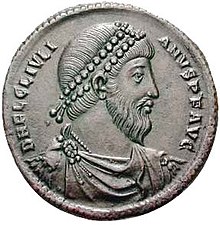Helena (daughter of Constantine the Great)
Helena (* before 326; † late 360 ), with full name Flavia Helena , was the daughter of Constantine the Great (Roman Emperor 306–337) and a member of the Constantinian dynasty he founded . In 355 she married the future emperor Julian .
Contemporary history background
The Roman Empire went through a profound change at the beginning of the 4th century. Helena's father Constantine had prevailed in the succession struggles that broke out with the end of the tetrarchy founded by Emperor Diocletian and thus founded the Constantinian dynasty, of which Helena's later husband Julian was the last member. Constantine initiated the Constantinian turn towards Christianity and in 330 moved the residence of the Roman emperor to Constantinople . He died in May 337. A number of murders occurred during the turmoil that followed his death .
The successors to Constantine were his sons Constantine II , Constantius II and Constans . Constantine II died in 340 when he tried to attack his younger brother Constans. This fell in 350 in the fight against the usurper Magnentius . Constantius II installed Julian's brother Gallus as sub-emperor ( Caesar ) for the east of the empire. Gallus, however, made various domestic political mistakes and was finally lured to the West by Constantius II, imprisoned there and finally executed.
Life
Birth and wedding with Julian
Helena was born the daughter of Constantine and his wife Fausta , her siblings were the three future emperors Konstantin, Constantius and Constans as well as the sister Constantina . Helena was named after her grandmother Helena . She was the youngest daughter of Constantine - whether she was born before 323, that is, before the youngest brother Constans, or after Constans and before the death of her mother in 326, is uncertain.
In 355 her brother Constantius married her to Julian , her cousin, whom he had recently made Caesar on November 6, 355 . The wedding took place in Mediolanum (now Milan ). She moved with Julian to Gaul , where she became pregnant. However, the son died after giving birth. Allegedly, Eusebia , Constantius's wife, hired a midwife to kill the child immediately after it was born. She prevented further pregnancies by using poison to deprive Julian of his potential successor. When Constantius visited Rome in 357 , she was staying at the emperor's court. In Cologne she built the church of St. Gereon with Julian , which today is often wrongly attributed to her grandmother of the same name.
Helena's death
Helena was present when her husband was proclaimed Augustus by his soldiers in February / March 360 in Lutetia (Paris) . But the following winter she died during the Quinquennalien , the celebration of Julian's fifth anniversary in government. It can be speculated that she died in another miscarriage, but there is no evidence. After the death of Eusebia, who had already died in early 360, Helena was the last connection in the tense relationship between Julian and her brother Constantius.
Helena was buried with her sister Constantina on the Via Nomentana near Rome. Her grave was later transferred to Constantinople by Emperor Theodosius I , where she found her final resting place next to her husband.
Helena is described as a devout Catholic, which is why her relationship with Julian, who as a staunch pagan wanted to reverse the advance of Christianity, could have been problematic. After her death, rumors arose that Julian had let her be poisoned. Another reason for the rather unhappy marriage seems to have been that Julian always thought his friends and his education were more important than his wife.
swell
The main source for the time after Constantine the Great is the historical work of Ammianus Marcellinus (from 353 AD). Ammian describes Julian and his deeds in detail and addresses Helena in various places. Another source for Helena is Julian himself, who was also active as an author (→ works by Julian ). The most important event in Helena's life, the wedding with Julian, is also mentioned by other historians, such as Zosimos (3.2.1), Eutropius (10.14), Socrates Scholastikos (3.1.25), Sozomenos (5.2 , 20), who incorrectly names her Constantina , and Philostorgios (4,2). John Zonaras mentions her birth (13,2,36).
- Ammianus Marcellinus 15,8,18; 16,10,18; 21,1,5; 21,10,19; 25.4.2.
literature
- Arnold Hugh Martin Jones , John Robert Martindale, John Morris : Helena 2. In: The Prosopography of the Later Roman Empire (PLRE). Volume 1, Cambridge University Press, Cambridge 1971, ISBN 0-521-07233-6 , pp. 409-410 ( online version ).
- Otto Seeck : Helena 4). In: Paulys Realencyclopadie der classischen Antiquity Science (RE). Volume VII, 2, Stuttgart 1912, Col. 2822 f.
- Rudolf Hanslik : Helena 2. In: The Little Pauly (KlP). Volume 2, Stuttgart 1967, column 989.
- Klaus Rosen : Julian. Emperor, God and haters of Christians . Klett-Cotta, Stuttgart 2006, ISBN 3-608-94296-3 , pp. 133f, 171, 198, 395.
- Noël Aujoulat: Eusébie, Hélène et Julien . In: Byzantion. Vol. 53, 1983, pp. 78-103 (I); 421-452 (II).
Web links
- Michael DiMaio, Jr.: Short biography (English) at De Imperatoribus Romanis (with references).
Remarks
- ↑ Ammianus Marcellinus 16: 10, 18-19.
- ↑ This visit to Rome is described in detail by Ammianus Marcellinus (16.10). A reference to Helena (see above) can be found at 16,10,18.
- ↑ Leon Grammatikos , Chronographia 94.
- ↑ Liber Pontificalis 37.4, where she is mistakenly named Constantina ; PLRE I, p. 410.
- ↑ Libanios , Speech 37: 3; John Zonaras 13:11, 2.
| personal data | |
|---|---|
| SURNAME | Helena |
| ALTERNATIVE NAMES | Flavia Helena |
| BRIEF DESCRIPTION | Daughter of Constantine the Great and wife of Emperor Julian |
| DATE OF BIRTH | before 326 |
| DATE OF DEATH | 360 |

